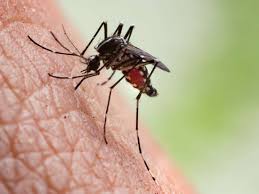Mosquitoes (alternate spelling mosquitos) are a group of about 3,500 species of small insects that are flies (order Diptera). Within Diptera they constitute the family Culicidae (from the Latin culex meaning “gnat”). The word “mosquito” (formed by mosca and diminutive -ito)is Spanish for “little fly”. Mosquitoes have a slender segmented body, one pair of wings, one pair of halteres, three pairs of long hair-like legs, and elongated mouthparts.
The mosquito life cycle consists of egg, larva, pupa, and adult stages. Eggs are laid on the water surface; they hatch into motile larvae that feed on aquatic algae and organic material. The adult females of most species have tube-like mouthparts (called a proboscis) that can pierce the skin of a host and feed on blood, which contains protein and iron needed to produce eggs. Thousands of mosquito species feed on the blood of various hosts — vertebrates, including mammals, birds, reptiles, amphibians, and some fish; along with some invertebrates, primarily other arthropods. This loss of blood is seldom of any importance to the host.




